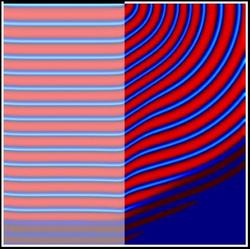Waves Will Be Waves

Nature sometimes adds a twist to the familiar type of diffusion where molecules simply wander along through a medium, ignoring one another most of the time. In reaction-diffusion systems, molecules react chemically with each other when they collide, so a chemical wave can propagate as the concentrations of the components change. These chemical waves, claims a report in the 8 June issue of PRL, conform to Snell’s law–the simple rule that dictates the angles of reflection and refraction when light waves hit an interface. The authors mathematically derive the phenomenon, which was observed by others, and show with computer simulations that their formulation agrees with experiments.
In 1993 Anatol Zhabotinsky, of Brandeis University in Boston, and his colleagues demonstrated reflection and refraction of chemical waves using a reaction in silica gel where one of the reactants was easily visualized. Since oxygen above the gel affected the reaction rate, covering half the gel with a glass plate created two distinct media with different speeds of chemical wave propagation, and they found Snell’s law held at the interface.
It’s surprising for chemical waves to follow Snell’s law because reaction-diffusion systems are nonlinear. The medium in these systems is active and is an inextricable part of the wave, unlike say, a sound wave, which vibrates the air or water it travels in, but otherwise leaves it unchanged. A wave of sound or light crossing the boundary between two different media obeys Snell’s law because of continuity: certain wave properties cannot change suddenly across the boundary. But nonlinear systems are not held to this constraint.
According to Rui Dilão, of the Instituto Superior Técnico in Lisbon, Portugal, the constraint in reaction-diffusion systems is that after the reaction the media must be chemically identical, even if the reaction occurred at different rates in the two media. While the waves are plowing through and reactions are taking place, the media have different properties–such as different wave propagation speeds–but the waves transform their media into the same final species.
By solving the reaction-diffusion equations using this constraint, Dilão and Joaquim Sainhas have now shown mathematically that chemical waves obey Snell’s law. They also ran computer simulations of chemical waves traveling across a boundary between media with different propagation speeds and found that their theory and simulations agree with the experiments of Zhabotinsky et al. and others. Dilão and Sainhas also found that what experimenters had interpreted as reflection is actually a “back refraction.” Under the right conditions, the concentration wave builds up at the interface and sends a new wave back into the original medium at the Snell’s law angle of refraction, rather than the reflection angle.
Physicists are keen to understand reaction-diffusion systems because they are common in nature–molecules inside tissues and cells move about by diffusing through and reacting with the stuff inside the cell. The details of this reaction and diffusion account for things like the eyespots of butterflies and even the stripes of zebras. Indeed, says Dilão, at a recent meeting they have already presented predictions of how butterfly eyespots will form based on reaction-diffusion calculations.
–Meher Antia
Meher Antia is a freelance science writer.


